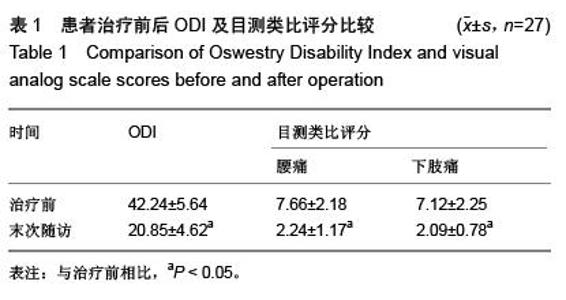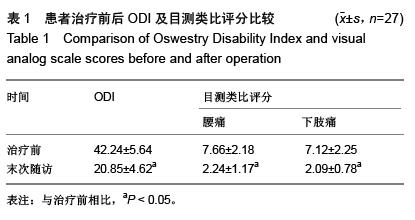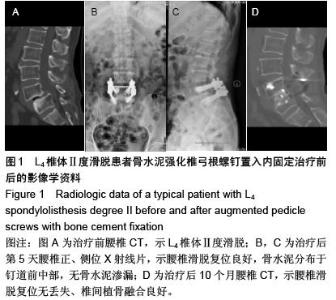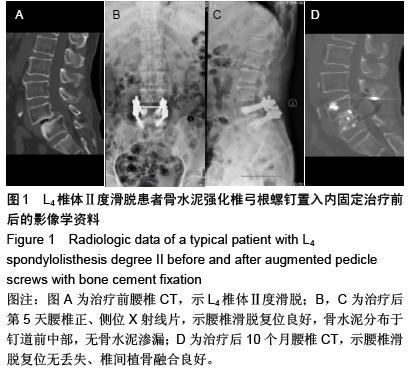| [1] Roy CR, Saillant G, Mazel C. Intenral fixation of the lumbar spine with pedicle screw plating. Clin Orthop. 1986;(203): 7-17.
[2] Essens SI, Sachs BL, Dreyzin V. Complications associated with the technique of pedicle screw fixation: a selected survey of ABS members. Spine. 1993;18(15):2231-2239.
[3] Okuyama K, Sato K, Abe E, et al. Stability of transpedicle screwing for the osteoporotic spine: an in vitro study of the mechanical stability. Spine. 1993;18(15):2240-2245.
[4] 毛宁方,石志才.骨水泥在脊柱外科中的应用现状与进展[J]. 脊柱外科杂志, 2006,4(4):239-242.
[5] Harms JG, Jeszenszky D.The unilateral transforaminal approach for posterior lumbar interbody fusion. Orthop Traumatol. 1998;6(2):88-89.
[6] Aitken RC. Measurement of feelings using visual analogue scales. Proc R Soc Med. 1969;62(10):989-993.
[7] Fairbank JC, Pynsent PB. The Oswestry disability index. Spine. 2000;25(22):2940-2953.
[8] Sengupta DK, Truumees E, Patel CK, et al. Outcome of local bone versus autogenous iliac crest bone graft in the instrument posterlateral fusion of the lumbar spine. Spine. 2006;31(9):985-991.
[9] Hitchon PW, Brenton MD, Black AG, et al. In vitro biomechanical comparison of pedicle screw s sublam inar hooks and sublam inar cables. J Neursurg. 2003;99(1 Supp l) : 104-109.
[10] Pfeifer BA , Krag MH, Johnson C. Rapair of failed transpedicle screw fixation. A biomechanical study comparing polymethylmethacrylate, milled bone and match stick bone reconstruction.Spine. 1994;19(3):350-353.
[11] Soshi S, Shiba R, Kondo H, et al. An experimental study on transpedicular screw fixation in relation to osteoporosis of the lumbar spine. Spine. 1991;16(11):1335-1341.
[12] Tan JS, Bailey CS, Dvorak MF, et al. Cement augmentation of vertebral screws enhances the interface strength between interbody device and bertebral body. Spine. 2007;32(3):334-341.
[13] 高梁斌,陈嘉裕,张亮,等.经皮椎体成形术中骨水泥注射量与疗效和并发症的相关性研究[J]. 中华创伤骨科杂志,2009,11(9): 532-536.
[14] Chang MC, Liu CL, Chen TH. Polymethlmethylmethacrylate augmentation of pedicle screw for osteoporotic spinal sugery: a novel technique. Spine. 2008;33(10):E317-E324.
[15] Bechker S, Chavanne A, Spitaler R, et al. Assessment of different screw augmentation techniques and screw designs in osteoporotic spines. Eur Spine J. 2008;17(11):1462-1469.
[16] Ryu KS, Park CK, Kim MC, et al. Dose-dependent epidural leakage of polymethlmethylmethacrylate after percutaneous vertebroplasty in patients with osteoporotic vertebral compression fractures. J Neurosurg. 2002;96(1 Suppl):56-61.
[17] 吴子祥,樊勇,雷伟,等.膨胀式椎弓根螺钉结合骨水泥强化钉道在严重骨质疏松脊柱手术中的应用[J]. 中华创伤骨科杂志,2011, 13(2):114-118.
[18] 章筛林,石志才,张晔,等.骨水泥椎体强化在骨质疏松患者行椎弓根钉内固定中的应用[J]. 脊柱外科杂志,2008,6(2):95-98.
[19] El Saman A, Kelm A, Meier S, et al. Intraoperative PEEP-ventilation during PMMA-injection for augmented pedicle screws: improvement of leakage rate in spinal surgery. Eur J Trauma Emerg Surg. 2013;39(5):461-468.
[20] El Saman A, Meier S, Sander A, et al. Reduced loosening rate and loss of correction following posterior stabilization with or without PMMA augmentation of pedicle screws in vertebral fractures in the elderly. Eur J Trauma Emerg Surg. 2013;39(5): 455-460.
[21] Ferland CE, Sardar ZM, Abduljabbar F, et al. Bilateral vascularized rib grafts to promote spinopelvic fixation in patients with sacral agenesis and spinopelvic dissociation: a new surgical technique. Spine J. 2015;15(12):2583-2592.
[22] Mazur MD, Ravindra VM, Dailey AT, et al. Rigid Posterior Lumbopelvic Fixation without Formal Debridement for Pyogenic Vertebral Diskitis and Osteomyelitis Involving the Lumbosacral Junction: Technical Report. Front Surg. 2015;2: 47.
[23] Liu Y, Xu J, Sun D, et al. Biomechanical and finite element analyses of bone cement-Injectable cannulated pedicle screw fixation in osteoporotic bone. J Biomed Mater Res B Appl Biomater. 2015.
[24] Christodoulou E, Chinthakunta S, Reddy D, et al. Axial pullout strength comparison of different screw designs: fenestrated screw, dual outer diameter screw and standard pedicle screw. Scoliosis. 2015;10:15.
[25] Kang SH, Cho YJ, Kim YB, et al. Pullout strength after expandable polymethylmethacrylate transpedicular screw augmentation for pedicle screw loosening. J Korean Neurosurg Soc. 2015;57(4):229-234.
[26] Csaba P, Misik F, Papp Z, et al. [Treatment of osteoporotic vertebral compression fractures with PMMA-augmented pedicle screw fixation]. Ideggyogy Sz. 2015;68(1-2):52-58.
[27] Moussazadeh N, Rubin DG, McLaughlin L, et al. Short-segment percutaneous pedicle screw fixation with cement augmentation for tumor-induced spinal instability. Spine J. 2015;15(7):1609-1617.
[28] Yi S, Rim DC, Park SW, et al. Biomechanical Comparisons of Pull Out Strengths After Pedicle Screw Augmentation with Hydroxyapatite, Calcium Phosphate, or Polymethylmethacrylate in the Cadaveric Spine. World Neurosurg. 2015;83(6):976-981.
[29] Charles YP, Pelletier H, Hydier P, et al. Pullout characteristics of percutaneous pedicle screws with different cement augmentation methods in elderly spines: An in vitro biomechanical study. Orthop Traumatol Surg Res. 2015; 101(3): 369-374.
[30] Colmana M, Pondb J, Bachusc K, et al. Fenestrated Screws Augmented with PMMA Increase the Pull-out Strength of Sacral Pedicle Screws. J Spinal Disord Tech. 2014. [Epub ahead of print]
[31] Yilmaz G, Hwang S, Oto M, et al. Surgical treatment of scoliosis in osteogenesis imperfecta with cement-augmented pedicle screw instrumentation. J Spinal Disord Tech. 2014; 27(3): 174-180.
[32] Chen YL, Chen WC, Chou CW, et al. Biomechanical study of expandable pedicle screw fixation in severe osteoporotic bone comparing with conventional and cement-augmented pedicle screws. Med Eng Phys. 2014;36(11):1416-1420.
[33] Güler UO, Derincek A, Hersekli MA, et al. Restoration of pull-out strength of the failed pedicle screw: biomechanical comparison of calcium sulfate vs polymethylmethacrylate augmentation. Acta Orthop Traumatol Turc. 2014;48(2): 202-206.
[34] Yuan Q, Zhang G, Wu J, et al. Clinical evaluation of the polymethylmethacrylate-augmented thoracic and lumbar pedicle screw fixation guided by the three-dimensional navigation for the osteoporosis patients. Eur Spine J. 2015; 24(5):1043-1050.
[35] Mesfin A, Komanski CB, Khanna AJ. Failure of cement-augmented pedicle screws in the osteoporotic spine: a case report. Geriatr Orthop Surg Rehabil. 2013;4(3):84-88.
[36] Liu D, Zhang Y, Zhang B, et al. Comparison of expansive pedicle screw and polymethylmethacrylate-augmented pedicle screw in osteoporotic sheep lumbar vertebrae: biomechanical and interfacial evaluations. PLoS One. 2013; 8(9):e74827.
[37] Wegmann K, Gick S, Heidemann C, et al. Biomechanical evaluation of the primary stability of pedicle screws after augmentation with an innovative bone stabilizing system. Arch Orthop Trauma Surg. 2013;133(11):1493-1499.
[38] Chang MC, Kao HC, Ying SH, et al. Polymethylmethacrylate augmentation of cannulated pedicle screws for fixation in osteoporotic spines and comparison of its clinical results and biomechanical characteristics with the needle injection method. J Spinal Disord Tech. 2013;26(6):305-315.
[39] Liu D, Zhang Y, Lei W, et al. Comparison of 2 kinds of pedicle screws in primary spinal instrumentation: biomechanical and interfacial evaluations in sheep vertebrae in vitro. J Spinal Disord Tech. 2014;27(2):E72-80. |



